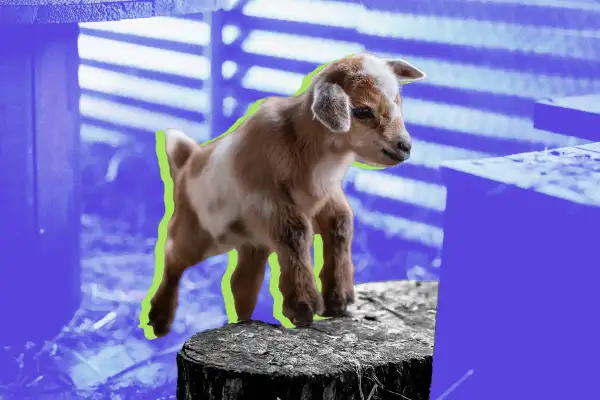Mini Cows, Sheep and Goats Are the Latest Cute (but Costly) Pet Craze

When Cassandra Lambert wraps up her workday managing an auto-parts store in Laramie, Wyoming, the 49-year-old is eager to get back home and walk her two pets.
Not dogs, though; Lambert is the proud (pet) parent of a pair of pint-sized goats.
“I used to live in Montana when I was a kid and I always wanted to have goats again,” Lambert says. Instead of the full-sized dairy goats on the family farm, though, Lambert opted for two dwarf Norwegian goats, which top out at just a couple of feet in height.
Lambert is one of a growing number of Americans looking beyond dogs and cats when they seek out furry companions. Breeders, ranchers and those who rescue mini farm animals say there’s been a surge of interest in people keeping them for “hobby” farms or as pets.
It can be hard to get a handle on exactly how many people own mini farm animals. Registries for livestock like miniature horses, cows, goats, sheep and pigs aren’t typically set up to distinguish between owners like Lambert and people who keep large herds for breeding, milk or meat, says Donna Grace, founding director and registrar of the Homestead & Miniature Cattle Directory.
“I do certainly believe there are more out there than we realize,” she says, especially because many “cute” breeds that become social media stars are essentially mutts — crossbreeds or non-recognized breeds.
Even without official numbers, there are indirect indicators that mini farm animals are a rising trend: Jennifer Clark, founder of J&J Second Chance Small Holdings, a mini farm animal rescue in Rock River, Wyoming, holds classes for new owners of miniature goats. While she used to teach one or two people a few times a year, now she’s running classes every month with five students each.
“They get ahead of themselves and purchase animals, and don't have knowledge except what they’ve learned on TikTok,” she says. “There's a lot of realities to having farm animals that you don’t realize.”
TikTok videos, Instagram reels and other social media posts of people holding or petting cute, pint-sized goats, cows, pigs and more have turned these miniatures into “designer animals,” says Ronda Webber, owner of Blossom Farm in Ferndale, Washington, a sanctuary for miniature farm animals surrendered by owners.
Little animals bring in big bucks
Those cute, cuddly faces can be big business for people who sell them — another reason the mini farm animals trend is going strong. “Pet cattle are worth whatever price they will bring. In spite of not being registered, some bring a lot of money,” Grace, who founded the cattle directory, says.
Mini cows, especially the shaggy-haired miniature Highland cattle that are popular on social media, are on the pricey end of the spectrum, with calves selling for thousands of dollars. Mini horses and ponies can command similarly high prices, while mini pig prices start under $1,000 and small goats, typically the most affordable of the bunch, can be bought for a few hundred dollars.
Lambert says she initially looked into buying her goats, Baxter and Dexter, from local breeders — “You can spend $500, $600,” she says. Instead, she wound up adopting from a sanctuary.
Backyard farm animals have delivered a boost to businesses like Tractor Supply Company in recent years. The pandemic triggered a migration from urban to rural areas, while supply chain issues and shortages followed by inflation made people rethink their reliance on supermarkets and consider growing or raising their own food. Tractor Supply president and CEO Hal Lawton noted in 2022 that the influx of millennials to rural communities was driving sales of everything from animal feed to riding lawn mowers. He told investors earlier this year that “the rural migration trend is one that's here to stay for the time being.”
John Bartheld, owner of Murray Creek Ranch in Roy, Washington, has been a breeder of miniature cattle for more than 20 years. Some of his mini calves cost more than $8,000, and he has had a waiting list for his animals since 2015.
Since the pandemic, though, he says he has been inundated with calls, emails and queries from people asking about miniature cows, which some social media users have dubbed grass puppies or pasture puppies. "It’s almost overwhelming with the emails,” he says.
While Bartheld says most of his eventual buyers invest the time into researching and learning about these animals, some are taken by their fluffy coats, big eyes and boopable noses, and only grasp the reality of what it means to have a farm animal as a pet when it takes over their lawn.
“This is basically a backyard livestock animal. They don't realize that this thing poops all over the place and their little backyard turns into a pasture,” he says. “It’s not like going out with a pooper scooper or a baggie on your hand. We’re talking wheelbarrows.”
Mini farm animals can make pricey pets
The care and feeding of farm animals can be very different — and sometimes much pricier — than cats or dogs. Vet bills may be comparable for people who live in rural areas with high demand for livestock vets. But people living in suburbia are likely to find it challenging and expensive to find a livestock vet who will come to their house — a necessity for animals that can’t be transported in a crate or the back of a car.
Fencing is another expense mini farm animal experts say owners can’t afford to skimp on: Nearly all need to be sturdier than a fence that would corral a dog. Depending on the farm animal, fences might need to be taller, sunk deeper or constructed of materials with fewer or smaller openings to prevent curious animals from jumping, digging or just plowing their way out.
“My old fencing had four-by-four inch holes. They can fit through that,” Lambert says of her two goats. She ultimately spent almost $400 on fencing for her goats’ enclosure.
Another expense that catches new owners unaware is bringing home a farm animal without finding out beforehand if their city or county will let them have, say, a backyard cow or pig.
“They don’t check the local farm laws and jurisdiction stuff to make sure what they want is something they can have,” Webber says. At best, this means paying hefty fines. At worst, it can mean surrendering the animal or having to pay hundreds of dollars a month to board it at an approved facility.
The Hobby Farm Guys, a trio of Idaho-based vloggers, note in a YouTube video about mini farm animals that when it comes to livestock, “mini” is a relative term. Miniature cattle, for instance, can still tip the scales at 500 pounds or so, and even “mini” pigs are usually heavier than 100 pounds when full-grown — proportions potential owners need to keep in mind when figuring out how much space and food their mini farm pets will need. Even miniature cattle eat 2% to 3% of their body weight a day — and the hay that makes up much of their nutrition has jumped in price over the past few years. “They’re going to cost about $250 a month in hay,” Clark says.
The myth that mini farm animals can subsist on scraps and backyard grass is enduring, but incorrect, experts say.
“My mini cow is like 500 pounds and she eats a bale in three days,” Webber says. While her property is large enough that she can purchase and store hay directly from the farmers who harvest it, people without the space to store all that hay are stuck paying much more. “We’re paying like $5 a bale, but the people buying it at the store are paying $20 a bale for hay,” she says. “I would say the whole thing costs more than people expect.”
There are also mineral blocks that can cost as much as $100 each, and owners hoping to milk their mini cattle have to buy grain, at up to $22 twice a week, Clark adds, not to mention equipment, such as enclosures for the animals, watering troughs and rodent-proof food containers, as well as higher power and water bills.
For owners like Lambert, though, the time and money is well worth it. “These are my babies, they're my pets,” she says.
More from Money:
The Big Challenges of Living in a Tiny Home
9 Hidden Costs of Owning a Pet
Inside the Business of Romantasy, Where Book Fans Mix Love, Literature and Profit






